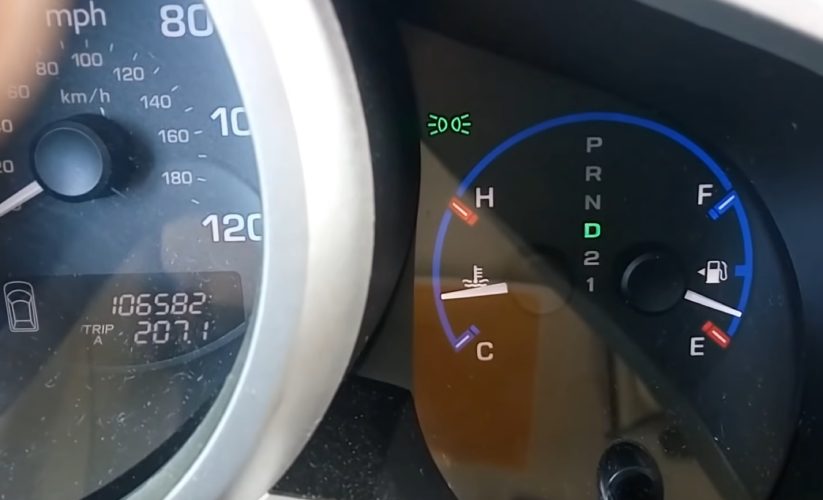Your Honda car is built with a Variable Torque Management 4-wheel-drive system which acts as a driver assist. The system functions automatically without the interference of the driver. The system oversees torque distribution to the rear wheels for better traction when driving on slippery surfaces.
What does it mean when the light comes on?
Like most lights on the dashboard, the VTM-4 light indicates a problem with the 4-wheel-drive system. To further understand issues relating to this system, it’s important to understand the system itself.

So, what is the VTM-4 system? The VTM-4 system is a system that automatically distributes torque to the rear wheels of the car for better grip. The system is safety conscious when driving on slippery roads. The moment it observes the wheel losing traction, it redirects applied torque to the wheels for better grip.
The VTM-4 lock button can be pressed in extreme weather conditions for better control. This manual method directs torque to the rear axles for better traction.
However, the lock button should not be pressed when driving in normal weather conditions as it could affect the rear differential as you turn. If the lock button is pressed when not needed, you’ll notice vibration due to the locked rear wheels and have an overall impact on your driving.
Therefore, if extra torque is not needed in the rear wheels, you should not use the lock button. Instead, allow the system to distribute the torque when needed automatically.
Related content: What Does Check Fuel Cap Mean On Your Honda?
Is the check engine light on as well?
The VTM-4 light and the check engine light often come on together. The check engine light often comes on when there’s an issue with the engine. Therefore, the illumination of both lights indicates a fault linking both systems.
What causes a VTM-4 light to come on?
Different causes could result in the illumination of both lights simultaneously. Some of them include:
Low oil in the engine
Low engine oil could trigger the activation of both lights; hence, if you see both lights come on, this is a good place to start your investigation. The oil level in the engine should be checked. If the oil level is lower than normal, it should be refilled with the automaker’s recommended oil.
If the oil level is appropriate, the oil quality should also be examined. Oil containing high amounts of dark debris or dark-colored oil should be drained and replaced.
In case of low oil levels, ensure that a leak is not present. If a leak is present, repair the leak before refilling the oil.
If you need to fill up your engine oil, it is an easy DIY and will cost you under $50. However, if an oil leak is present, sorting out the leak might cost you a couple of hundred. Driving with an oil leak might not be a good idea, so you might need to look into it as soon as possible.
Related content: Honda No Audio Connection – Meaning and Fixes
Loosened/ blown gasket
A bad gasket can lead to low oil levels. The oil pan comes with a gasket that helps prevent oil leakage. However, with time, the gasket deteriorates and leaks oil.
An ill-fitting gasket can lead to oil leakages as well. This could result from accumulated debris on the gasket or a loosened gasket. You might have a gasket issue if you notice smoke emitting from your engine.
Either way, your regular maintenance should involve inspecting your oil pan gasket to prevent oil leakage.
While this can be done at home, for a proper inspection, you might need to drive the car to a repair garage, as they have elevators allowing for easy access.
Front oxygen sensor
After inspection of your oil level and ensuring your oil pan gasket is in good condition, your oxygen sensors might be the reason for the illumination of the VTM-4 light and the check engine light.
Apart from the check engine light, a faulty oxygen sensor might show the following symptoms:
- Poor MPG
- Engine misfiring
- Rough idling
- Stalling
However, if your vehicle has under 100,000 miles, your oxygen sensor might not be the culprit.
Testing an oxygen sensor can be a relatively easy task if you have a multimeter. This will allow you to check if the heating element is still working. To do this, follow the steps below:
- Set the multimeter to resistance
- Connect the leads to the heater power
- Ground the connection pins or wires
- You should read a resistance of 10Ω to 20Ω
If you need to replace the oxygen sensor, the costs can be high if you get a professional to do it. Therefore, I recommend this as a DIY to save on costs. You can locate the front oxygen sensor by checking relevant documentation about your car. You can google this.
Expect to pay anywhere from $150 to $400, depending on the car model and whether you get a professional to do it or decide to replace it yourself. You can keep driving the car with a bad o2 sensor, but eventually, the vehicle will stall.
Related content: P1009 Honda- Meaning and Possible Causes
Tire pressure is not even on all the tires
If you notice your VTM-4 light and check engine light illuminated simultaneously, your tire pressure is a good place to start the inspection. Low tire pressure will affect the tires’ grip on the road and result in a loss of traction.
The tires should be pumped to adequate pressure to clear the warning lights. You should be able to find the correct tire pressure by checking for a sticker inside the driver’s door. Most cars recommend a tire pressure between 30 PSI and 35 PSI.
Stale transmission fluid
The transmission and the VTM-4 systems of a Honda are closely linked. Hence, an issue with the transmission system might be evident in the VTM-4 system.
Therefore, the transmission fluid should be checked to ensure that it is at the appropriate level. If not, the fluid should be filled till the recommended mark is reached.
If the quantity of the fluid is sufficient, the quality should be examined next. The color and smell of the fluid are one good way to tell if it is past its expiration date.
A cloudy appearance and a burnt smell show that the transmission fluid is stale. If expired, the transmission fluid should be drained and replaced by a recommended brand.
Faulty idle air control valve
If rough idling is noticed alongside illumination of both lights (VTM-4 and check engine), the idle air control (IAC) valve should be suspected. You might also notice your car stalling or vibrating excessively when driving.
If unsure where this control valve is located, it is usually mounted on the throttle body or the intake manifold.
Testing for a faulty IAC valve is relatively easy if you have a voltmeter and a couple of hours. You can follow the steps listed below:
- Locate the IAC valve and remove the screws holding it to the throttle body or the intake manifold.
- Unplug the electrical connections
- Look for the valve openings
- Set the multimeter to resistance mode (Ohms)
- Use the multimeter leads to touch each end of the valve. You should get a reading between 0.00 – 0.05
- Check for any dirt inside the valve if the reading is within the accepted range. If the reading is higher, it indicates a faulty idle air control valve that needs to be replaced.
- Installing a new valve is pretty easy, as you follow the steps described above in reverse motion.
- After replacing the valve or sensor, you need to allow the engine a couple of minutes to idle when starting it for the first time. This will enable the IAC valve to learn the correct airflow required for the engine to run efficiently.
Related content: Honda SRS Light – Meaning, Resetting, and Causes
How do I clear the VTM-4 light?
First, try
The VTM-4 light illumination might be a result of a power glitch. In this case, turning the car on and off might solve the issue.
Put the car in drive and turn off the engine while the vehicle is moving. I did it at five mph a couple of times in a safe area.
Next
If that didn’t fix it, get a scan tool and check for error codes.
Using a diagnostic scanner on the car might be a fast way to confirm the fault. Once the codes pop up, check for the interpretation of the codes and work on the problem.
Related content: Honda Smart Key System Warning Light (Answered)
Bottomline
The VTM-4 system on the Honda Pilot is an efficient driver assist feature. However, like most systems in a car, faults sometimes develop that might affect the system’s normal operation. When this occurs, the warning light comes on and, most times, illuminates alongside the check engine light.
Since numerous reasons could cause this, your best bet in detecting the fault is to use a scanner to diagnose the issue. You could also examine certain parts of your car, such as the level and quality of the engine oil, transmission fluid, gasket condition, etc.
Every since I was a little boy, I can remember spending the afternoons in my dad’s repair shop. I got my first car at 16 and it was the best feeling ever!
I have contributed to various automotive publications but decided it’s finally time to settle for something constant.









